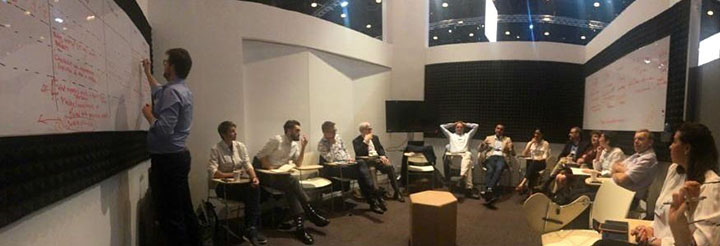Harnessing the Power of Technology for Mental Health
By
It’s 90 degrees Fahrenheit out. Sweat is pouring down my forehead. I look down at my cyclocomputer: 6 miles to go. I stop my furious pedaling, pull over to the side of the path, take a calming breath, and look around as I open a bottle of water. The landscape is full of rolling sand dunes like something out of Lawrence of Arabia. It should be. I’m cycling on Al Qudra bicycle track, a serpentine loop purpose-built into the desert in Dubai, UAE. Arriving half a day early for the annual meeting of the World Economic Forum (WEF) Global Futures Councils , I took the opportunity to engage in bicycle tourism, one of my favorite activities.

My smartphone and its apps, my cyclocomputer and its sophisticated software — these are technologies that help me plan and get the most out of my cycling experiences. They provide solutions to myriad problems and democratize these solutions. I didn’t pore over maps for hours or constantly stop to ask for directions to plan my next cycling adventure. I just pulled out my smartphone and consulted a few of my apps. In the palm of my hand, I planned out a cycling route, searched for a bike rental shop on a web mapping service, found a lunch spot — and I was on my way.
Imagine if we had such easy technological solutions to help guide our forays into mental health. How might devices and software help with mental health screening, diagnosis, and prevention? How might they connect individuals who have mental illnesses to providers or enhance access to care in remote and under-resourced settings? How might these technologies enable the use of relevant data for research and quality improvement? These were the very questions I contemplated as my computer guided me back to the bike shop; these were the questions I was in Dubai to address.
The WEF is best known for its annual meeting in Davos, Switzerland, where world leaders, academics, and international affairs experts gather to discuss global issues and strive to improve “the state of the world.” Much of the work of the WEF, however, is done by its Global Futures Councils. The Technology for Mental Health Council is one of these workgroups, aimed at fostering international collaborations to develop technological approaches that address mental health.
The idea that technology can be harnessed for mental health is not a new one. There are thousands of apps aimed at maintaining or improving mental health. Some facilitate connections to mental health professionals; others provide stand-alone treatment approaches or help individuals record their symptoms and monitor their progress. Newer tech approaches are also proving incredibly useful for research purposes. For example, NIMH-funded research groups and startup companies are examining the potential of using a combination of activity monitors, digital keyboards, and phone usage in addition to in-the-moment surveys to detect the onset of depression or mania more quickly.
In Dubai, ensconced in a white board-festooned pod in a modern conference center, WEF’s Technology for Mental Health Council discussed how our group might contribute to these efforts. In the room, we had academics, leaders of foundations and scientific societies, individuals with lived experience, global mental health advocates, tech and health care corporate representatives, a journal editor, and a neuroethicist. We debated approaches and priorities, and, at the end of the first day, we settled on a focus: tech approaches to reducing youth suicide, a growing problem around the world. The second day was spent discussing concrete plans for what we might accomplish as a group, including: a series of blogs, webinars, and conferences aimed at increasing the dialogue among technology companies, scientists, and those living with mental illnesses; and tools to understand the responsible use of technology aimed at identifying youth at risk for suicide. The resources of the WEF, the members of the council, and affiliated organizations will be brought to bear on fulfilling these plans over the coming year.

harnessing technology for mental health
One significant issue with mental health-related technologies such as smartphone apps is the need for rigorous scientific studies to demonstrate that such technologies actually work. For most smartphone apps, the consequences of failure are minimal. If your restaurant app search for a vegetarian restaurant sends you to a Korean barbecue joint, you check a different app instead. But ineffective technological solutions may have much more severe consequences for an individual living with a mental illness — particularly for someone experiencing suicidal thoughts. Getting these solutions right is crucial, and that means we need rigorously designed clinical trials to show that they work. Unlike some tech solutions, which are released with a consumer goods mindset, NIMH supports research aimed at demonstrating clinical efficacy — a crucial step for technologies that are designed to solve clinical problems.
Early returns from this research are promising. A couple of examples: Jukka-Pekka Onnela, Ph.D. , of the Harvard T. H. Chan School of Public Health is studying a smartphone-based approach to predicting relapse of schizophrenia symptoms. Smartphone data collected in a pilot study showed that participants’ patterns of behavior changed noticeably in the 2 weeks before they relapsed. Although more work is needed, this kind of technology could eventually allow clinicians to detect symptoms and intervene before relapse occurs. Meanwhile, software solutions for care delivery are achieving results. Findings suggest that PRIME — a digital motivation booster being studied by Sophia Vinogradov, M.D. , of the University of Minnesota Medical School and Danielle Schlosser, Ph.D. , of the University of California, San Francisco — can reduce depressive symptoms in individuals with schizophrenia.
This careful work is worthwhile for many reasons, but chief among them is the potential reach of technology. What I heard from my fellow council members in Dubai echoed what I’ve learned from visiting our research sites in Nepal, Kenya, and India, not to mention rural Louisiana and upstate New York. Access to mental health care is limited by resources, including a lack of qualified providers as well as insufficient funding and facilities. Effective technological solutions could help make up for this shortfall, helping guide people along their own serpentine paths through health care deserts to oases of recovery.
References
Barnett, I., Torous, J., Staples, P., Sandoval, L., Keshavan, M., & Onnela, J.- P. (2018). Relapse prediction in schizophrenia through digital phenotyping: A pilot study . Neuropsychopharmacology, 43, 1660-1666. doi:10.1038/s41386-018-0030-z
Schlosser, D. A., Campellone, T. R., Truong, B., Etter, K., Vergani, S., Komaiko, K., & Vinogradov, S. (2018). Efficacy of PRIME, a mobile app intervention designed to improve motivation in young people with schizophrenia . Schizophrenia Bulletin, 44(5), 1010-1020. doi:10.1093/schbul/sby078

